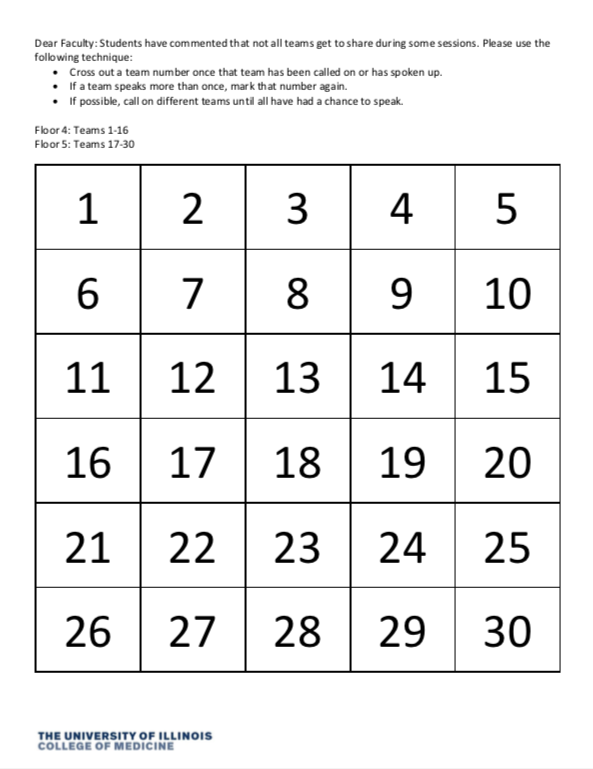Orienting Faculty in TBL Design and Delivery
Background of the Problem Heading link
TBL is a small group instructional method in which students are guided to apply conceptual knowledge through a recurring sequence of activities that involve individual work, teamwork, and immediate feedback. This method is now well-documented and accepted widely, validated through its adoption by many disciplines and across many countries around the world. The health professions are among the biggest adopters of TBL, with their concern for producing graduates who can think critically and apply concepts in practice. This section attempts to provide steps to orient faculty to the design and delivery of a TBL module for UICOM.
Steps in Orienting Faculty to TBL Facilitation Heading link
TBL can be a challenging delivery method for those who are unfamiliar with the timing, sequencing of activities, and large classroom management. Criteria for best practices in delivery of a TBL can be found here. (Note: if you cannot access this document, contact a coordinator or leader at your campus.)
Examples of Good Facilitation
What makes ‘good’ facilitation of a TBL? An excellent facilitator:
- addresses specific questions from the readiness assurance test (RAT)
- allows only 10 minutes for a clarifying discussion between tRAT and application exercises
- reminds teams to use the appeal process
- circulates around the room during team deliberation rather than mainly establishing a presence at the lectern or in another spot of the room during this period
- maintains good eye contact with students
- makes use of the bingo card (referenced below) to ensure that all teams have an opportunity to participate in discussions
- uses open-ended questions to probe thinking and reasoning rather than using closed questions which can stifle discussion
- makes good use of time management; recognizes when it is time to move on from a discussion point
For a more complete list of the best practices for delivering TBL, look at this document.
Some additional essentials to keep in mind:
- Meet with the instructional designer or other faculty development personnel prior to delivering the TBL to ensure you feel absolutely comfortable delivering content in this teaching method. TBLs are very rigid in design and delivery!
- Meet with the instructional designer or other faculty development personnel immediately after the TBL to debrief. If you are going to be a facilitator for a TBL, build in an additional 10 minutes to your schedule or so for after the TBL is finished.
- Work with the instructional designer(s) to design the TBL to ensure it follows TBL protocol.
- Connect with the information technology personnel and/or coordinators who can assist you with any specific logistical and technology needs.
- Facilitators will get feedback from the instructional designer or other faculty development personnel if they observed the TBL; they will also receive feedback from student evaluations and possibly RAT performance.
Bingo Card Heading link

For some campuses, a ‘bingo’ card is used with table / team numbers on it to reflect the number of teams attending the session. So as to not call on the same table repeatedly, this card is a way for facilitators to keep track of which tables they have called on, or which tables have responded already.
You can find an example of the bingo card here. Please feel free to make a copy to edit it for your specific needs. See the example to the right.
Twelve Tips for Facilitating a TBL Heading link
In an article by Gullo, Ha, and Cook (2015), the authors outline 12 tips for facilitating TBL.
Gullo, Ha, & Cook. (2015). Twelve tips for facilitating team-based learning. Medical Teacher, 37, 819-824. DOI: 10.3109/0142159X.2014.1001729
- Use the 4S’s to craft engaging questions.
- Watch the clock.
- Strategize the process of facilitation with faculty before class.
- Remember that facilitation is NOT delivery of content.
- Avoid giving away answers during facilitation phase.
- Provide time for closure.
- Wait for students to respond with questions.
- Ask neutral and open-ended questions.
- Rephrase or restate for clarity.
- Find the “student expert” in the room.
- Ensure any lingering uncertainties or disagreements are addressed.
- Hold each individual learner accountable.